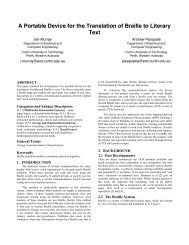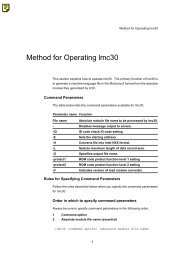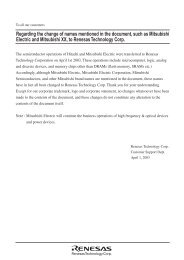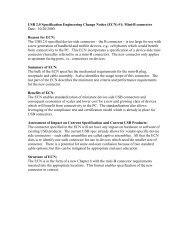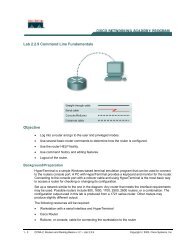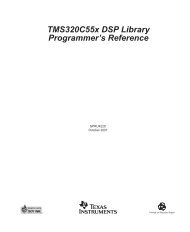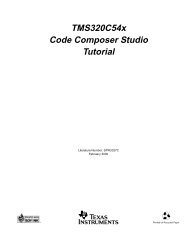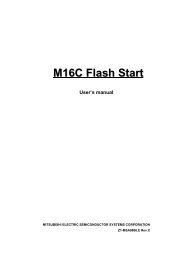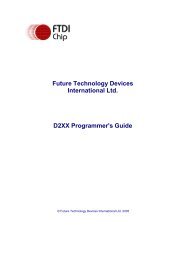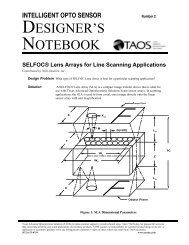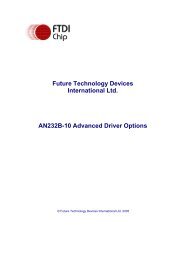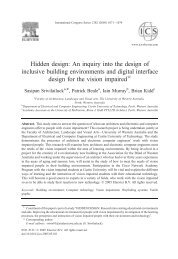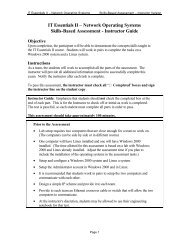You also want an ePaper? Increase the reach of your titles
YUMPU automatically turns print PDFs into web optimized ePapers that Google loves.
MemoryMitsubishi microcomputers<strong>M16C</strong> / <strong>62</strong> <strong>Group</strong>SINGLE-CHIP 16-BIT CMOS MICROCOMPUTEROperation of Functional BlocksThe <strong>M16C</strong>/<strong>62</strong> group accommodates certain units in a single chip. These units include ROM and RAM tostore instructions and data and the central processing unit (CPU) to execute arithmetic/logic operations.Also included are peripheral units such as timers, serial I/O, D-A converter, DMAC, CRC calculation circuit,A-D converter, and I/O ports.The following explains each unit.MemoryFigure 1.4.1 is a memory map of the <strong>M16C</strong>/<strong>62</strong> group. The address space extends the 1M bytes fromaddress 0000016 to FFFFF16. From FFFFF16 down is ROM. For example, in the M30<strong>62</strong>2MC-XXXFP, thereis 128K bytes of internal ROM from E000016 to FFFFF16. The vector table for fixed interrupts such as the_______reset and NMI are mapped to FFFDC16 to FFFFF16. The starting address of the interrupt routine is storedhere. The address of the vector table for timer interrupts, etc., can be set as desired using the internalregister (INTB). See the section on interrupts for details.From 0040016 up is RAM. For example, in the M30<strong>62</strong>2MC-XXXFP, 5K bytes of internal RAM is mapped tothe space from 0040016 to 017FF16. In addition to storing data, the RAM also stores the stack used whencalling subroutines and when interrupts are generated.The SFR area is mapped to 0000016 to 003FF16. This area accommodates the control registers for peripheraldevices such as I/O ports, A-D converter, serial I/O, and timers, etc. Figures 1.7.1 to 1.7.3 are locationof peripheral unit control registers. Any part of the SFR area that is not occupied is reserved and cannot beused for other purposes.The special page vector table is mapped to FFE0016 to FFFDB16. If the starting addresses of subroutinesor the destination addresses of jumps are stored here, subroutine call instructions and jump instructionscan be used as 2-byte instructions, reducing the number of program steps.In memory expansion mode and microprocessor mode, a part of the spaces are reserved and cannot beused. For example, in the M30<strong>62</strong>2MC-XXXFP, the following spaces cannot be used.• The space between 0180016 and 03FFF16 (Memory expansion and microprocessor modes)• The space between D000016 and D7FFF16 (Memory expansion mode)00000160040016SFR areaFor details, see Figures1.7.1 to 1.7.3FFE0016Type No. Address XXXXX16 Address YYYYY16M30<strong>62</strong>2M4 00FFF16 F800016M30<strong>62</strong>0M8 02BFF16 F000016M30<strong>62</strong>0MA02BFF16E800016M30<strong>62</strong>0MC/EC 02BFF16E000016M30<strong>62</strong>2M8/E8013FF16F000016M30<strong>62</strong>2MA017FF16E800016M30<strong>62</strong>2MC017FF16E000016M30<strong>62</strong>4MG/FG053FF16C000016XXXXX160400016 External areaD000016Internal reservedYYYYY16FFFFF16Internal RAM areaInternal reservedarea (Note 1)area (Note 2)Internal ROM areaFFFDC16FFFFF16Special pagevector tableUndefined instructionOverflowBRK instructionAddress matchSingle stepWatchdog timerDBCNMIResetNote 1: During memory expansion and microprocessor modes, can not be used.Note 2: In memory expansion mode, can not be used.Note 3: These memory maps show an instance in which PM13 is set to 0; but in thecase of M30<strong>62</strong>4MG/FG, they show an instance in which PM13 is set to 1.Figure 1.4.1. Memory map10



